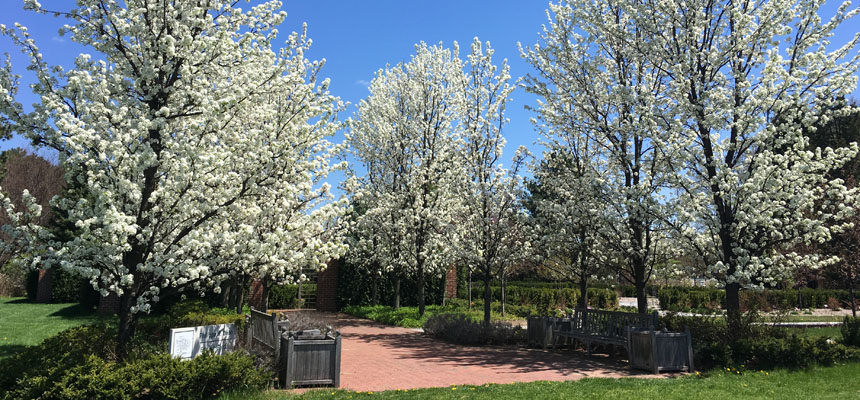Spring has finally come to Michigan! Some trees are leafing out while others are in full bloom. And we want to tackle the question: What is it? Differentiating between various flowering trees and shrubs opens our eyes to the unique and beautiful nuances of nature. But these plants can be tricky! There are some look-alike trees flowering right now and you’re about to learn how to know which tree is which!
White Flowering Trees
Coming into bloom in early spring are a few trees with white flowers. Of these trees, there are two that look similar from a distance and can be easily confused.
Serviceberry (Amelanchier canadensis)
A native tree to the Midwest, you might find this tree in natural areas as well as cultivated landscapes. Its small, white, star-shaped blooms cover the tree in a beautiful spring display. A unique feature of this plant is its smooth light grey bark. It can be grown as a multi-stem, large shrub or as a single-stem tree. After flowering, it produces blue berries that, as it turns out, taste a lot like blueberries. They are edible for humans, but you’ll have to fight off a myriad of birds and small mammals to try a bite! In addition to the spring bloom, Serviceberry leaves transform into a stunning orange-red fall color.
Flowering Pear (Pyrus calleryana)
As a common street and parking lot tree, flowering Pears are adaptable to harsh conditions. These trees are covered in clusters of small, rounded, 5 petal flowers that smell like, how do I put this…death. Newer cultivars of the trees don’t quite smell as bad as the older ones, but I recommend that you don’t stick your face into the flower to get a whiff.
Native to Asia and not the Midwest, you would expect to only find flowering Pear trees in the built environment. However, their seeds get dispersed by birds and animals that eat their “fruit” (not the same pears you would buy at the grocery store) and “deposit” them in natural areas, where they grow easily. This has caused a handful of states to list the trees as invasive and illegal to buy and sell.
Yellow Flowering Trees and Shrubs
Also blooming right now are look-alike trees and shrubs with yellow blooms.
Forsythia (Forsythia x intermedia)
Yellow spring blooming plants are often assumed to be Forsythia. But unfortunately, identifying this shrub is not that simple. First of all, notice that Forsythia are shrubs, and a thicket of shrubs, at that. Think of the story of Br’er Rabbit and the Tar-baby. Br’er Rabbit would have liked getting thrown into a thicket of Forsythia (though to be clear, Forsythia do not have thorns).
In spring, Forsythia branches are full of yellow, star-shaped flowers, about an inch in diameter. Forsythias produce flowers on last year’s new growth, so for the best floral display, they should be pruned immediately after flowering.
Cornelian Cherry Dogwood (Cornus mas)
When you think of Dogwood, you might think of large white or pink spring flowers. Or you might think of the red stems throughout winter. But this Dogwood is quite different than those more commonly known species. The Cornelian Cherry Dogwood is a tree that blooms with small, but pervasive, yellow flowers in early spring.
It does not sucker or make a thicket at its base, though it can be a single-stem or multi-stem tree. And perhaps its most unique ID feature is its mottled bark. After flowering, it produces bright red berries that are oblong in shape. They are edible for humans, tasting like tart cherries with a pit inside (and now the common name makes sense).
Vernal Witchhazel (Hamamelis vernalis)
This plant isn’t exactly a look-alike for the Forsythia or the Cornelian Cherry Dogwood, but it’s worth mentioning in this discussion. When it is still winter – anytime from January to March depending on the weather – the blooms open up. They are small, feathery, yellow flowers that cover the branches of the plant. The blooms are amazingly fragrant with a sweet scent that is a welcome harbinger of spring. It would be easy to see these yellow blooms in late winter and be tricked into thinking that the Forsythia have started blooming, but now you will not be fooled!
So, now that you are an expert in discerning white and yellow, spring blooming trees and shrubs, what plants still mix you up?

















What an excellent explanation. I thought I had a forsythia in my front yard and but now I know for sure. Thanks Kristin!! <3
As for the other plants that mix me up, I’m not sure but I do have one shrub that’s currently full of pink blooms whose name I do not know. That’s about it here 🙂 Thanks again!
Fun Kelly! Send me a picture of your shrub!
Can I send you a pic of my tree for identification? Thank you
Sure. Is the tree located in Michigan? If so, can you please send one picture of the overall tree and a second picture of an up-close view of the tree’s leaves or flowers? Please email kf@ElementsStudio.net